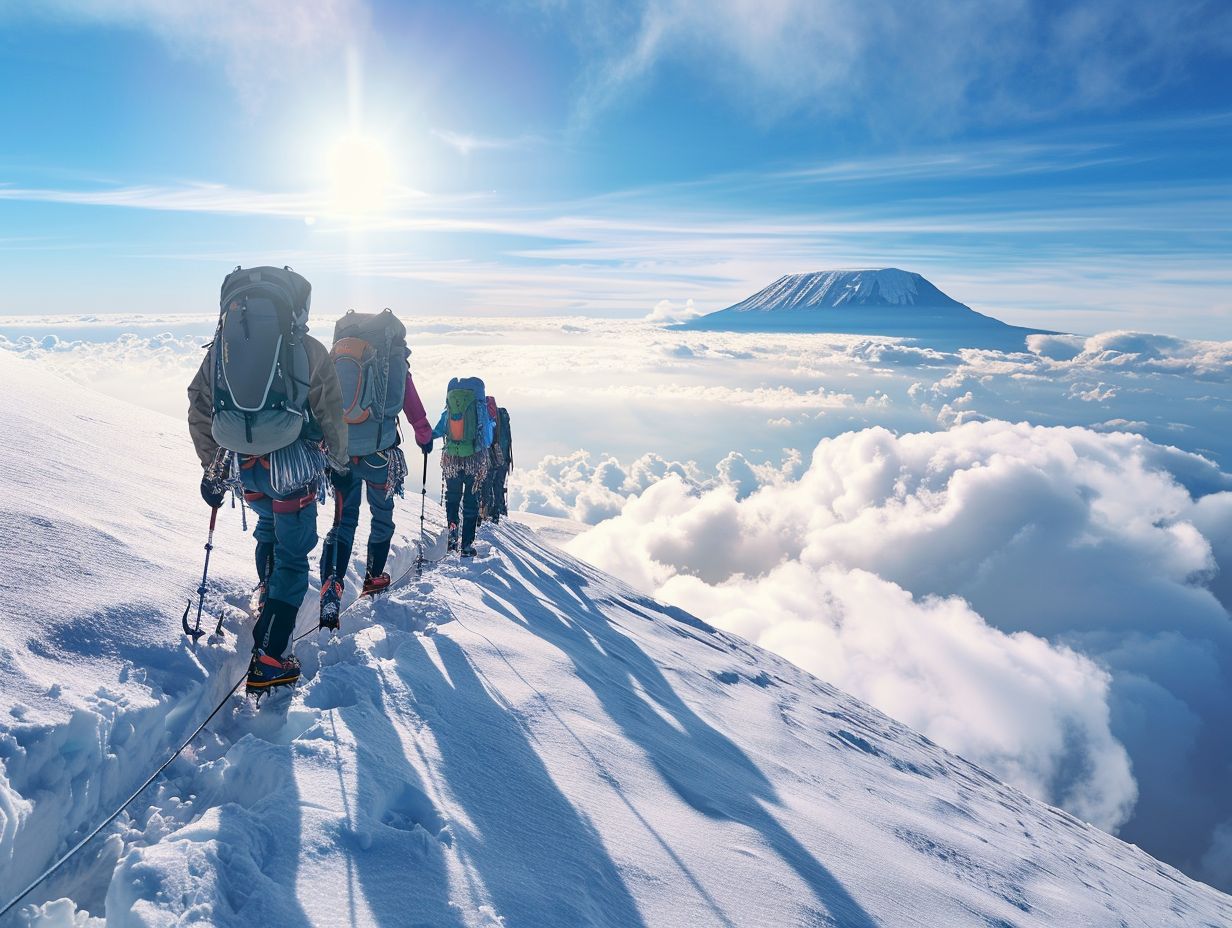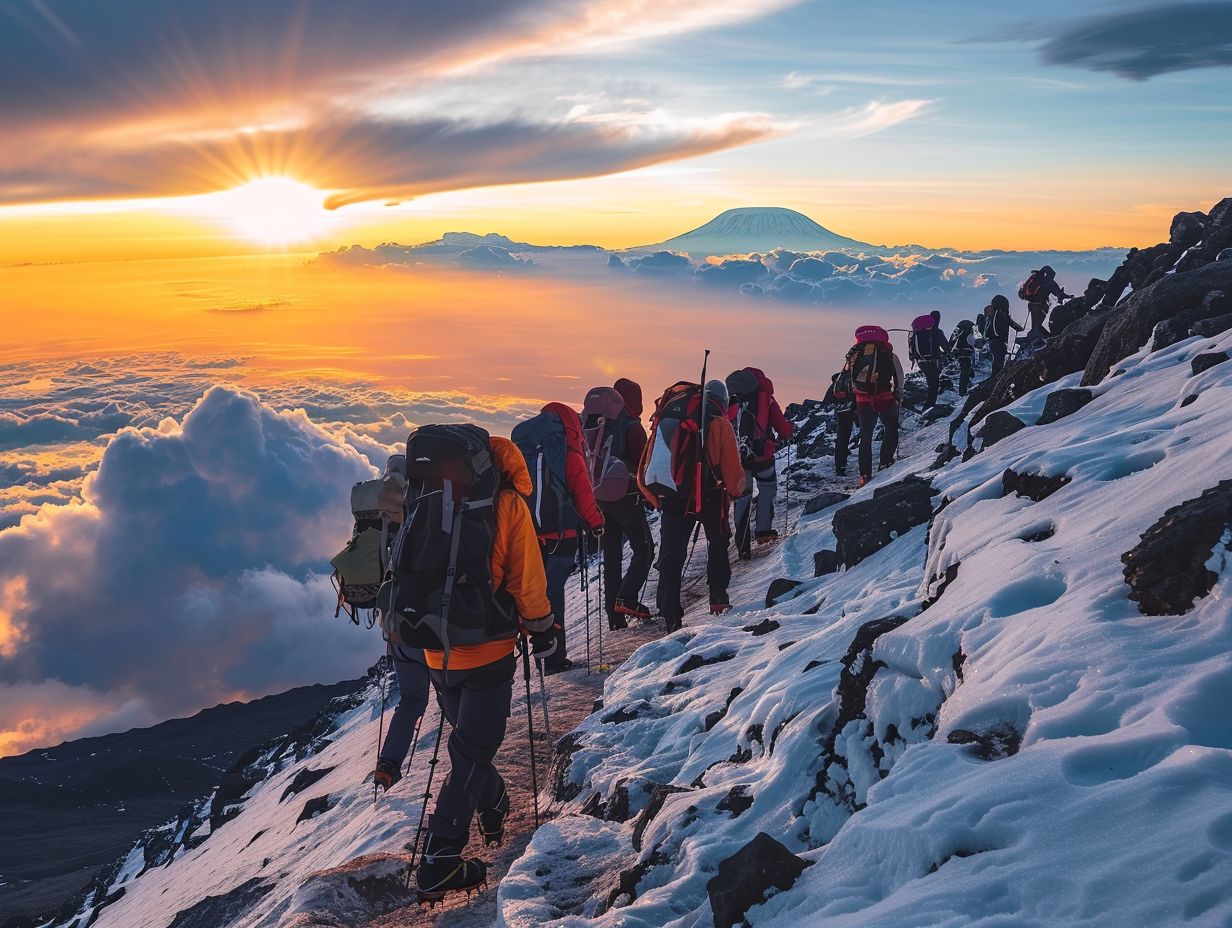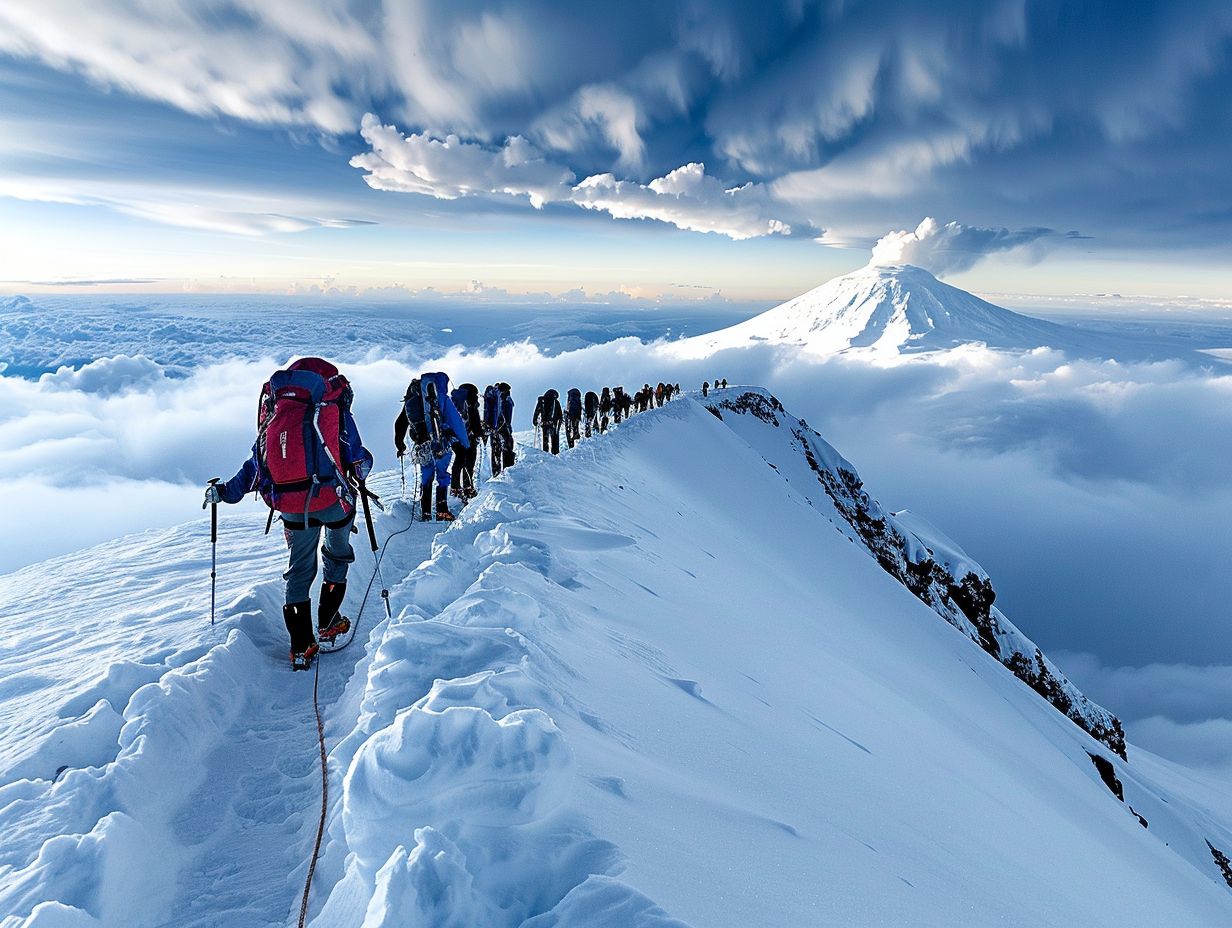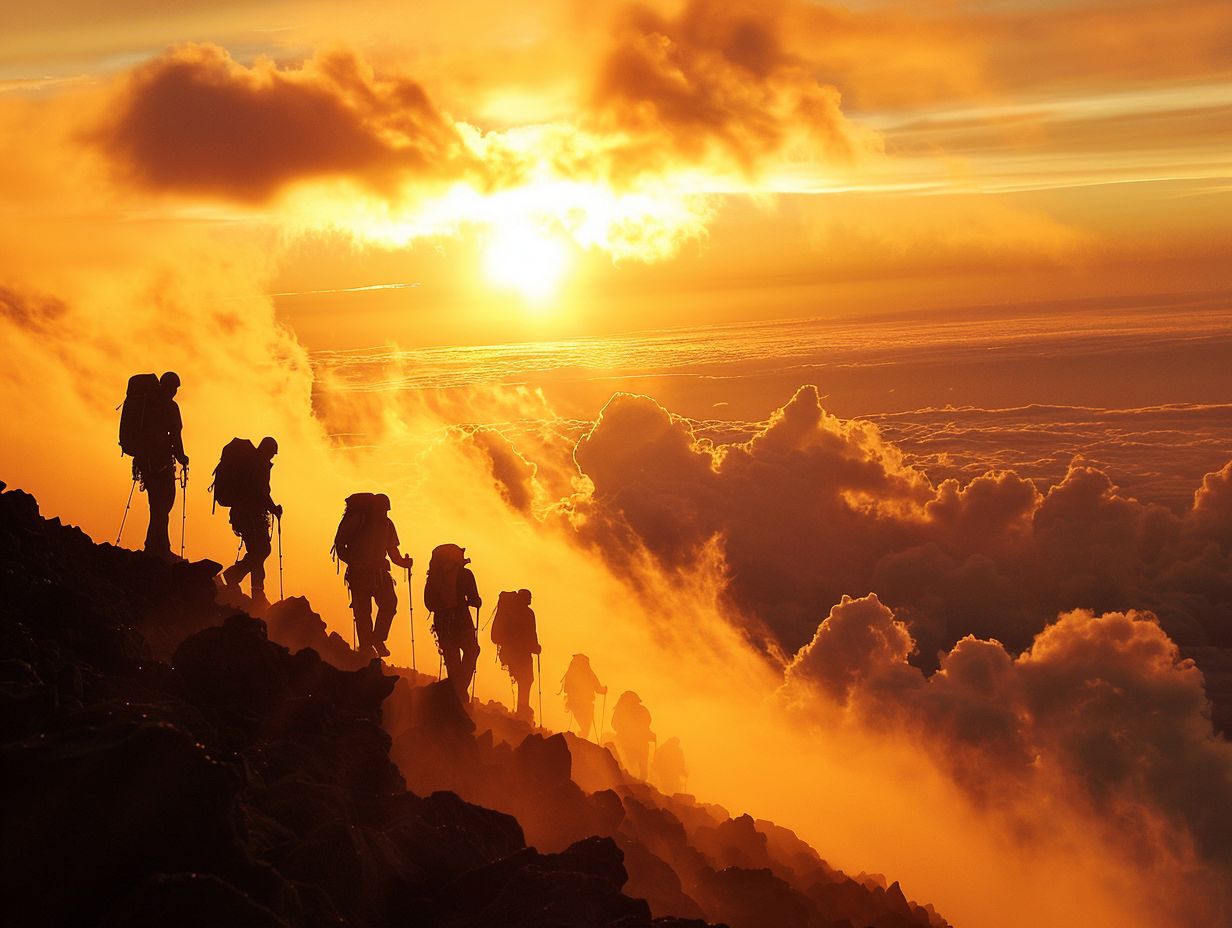
Kilimanjaro Fastest Ascent
Have you ever wondered what it takes to climb Kilimanjaro at record speed?
In this article, we will explore the fastest ascent of Kilimanjaro, including the current record holder and the route used for the speediest climb. We will also discuss the challenges of climbing Kilimanjaro, how to train for a fast ascent, and important safety precautions to consider.
Whether you’re a seasoned climber or just starting out, this article has everything you need to know about conquering Kilimanjaro in record time.
Key Takeaways:

- The fastest ascent of Kilimanjaro is a record-breaking feat, with the current record standing at just over 6 hours and 52 minutes.
- The route used for the fastest ascent is the Umbwe Route, which is known for its steep and challenging terrain.
- Climbing Kilimanjaro requires proper training and preparation, with recommended exercises including cardiovascular and strength training.
What Is Kilimanjaro?
Kilimanjaro, often referred to as the ‘Roof of Africa,’ is the highest mountain on the continent and stands majestically in Tanzania. It is a dormant volcanic mountain with multiple peaks, the highest of which is Uhuru Peak.
Kilimanjaro is famous for its three volcanic cones: Kibo, Mawenzi, and Shira. These cones give Kilimanjaro its unique shape and formation. Kibo, the highest peak, is home to the iconic Uhuru Peak, which stands at 5,895 meters above sea level.
Geographically, Kilimanjaro is located near the border of Tanzania and Kenya in East Africa. It is part of Kilimanjaro National Park, a UNESCO World Heritage Site, known for its diverse flora and fauna.
What Is the Fastest Ascent of Kilimanjaro?
The fastest ascent of Kilimanjaro is a remarkable feat achieved by Karl Egloff, setting a record pace that has become a benchmark for speed climbers. His incredible achievement has inspired many to push their limits in conquering this iconic mountain.
Karl Egloff’s record-breaking climb on Kilimanjaro not only shattered previous records but also showcased the epitome of human endurance and determination. His ability to conquer such challenges in the face of extreme conditions has captivated the climbing community worldwide.
Such expeditions come with a myriad of challenges, from battling high altitudes to enduring harsh weather conditions. The physical and mental resilience required to undertake such a fast ascent is immense, highlighting the sheer grit and skill possessed by climbers like Egloff.
This groundbreaking achievement has left a lasting impact on the climbing community, sparking a new wave of enthusiasm for speed climbing and redefining what was once thought possible on Kilimanjaro.
What Is the Current Record for the Fastest Ascent of Kilimanjaro?
The current record for the fastest ascent of Kilimanjaro is held by Karl Egloff, who achieved this incredible feat in an astonishingly short time, setting a new standard for speed climbers.
Egloff completed the arduous climb up Kilimanjaro, the highest peak in Africa, in a jaw-dropping time of just 6 hours, 42 minutes, and 24 seconds. He chose the lesser-known Umbwe route, known for its steep and challenging terrain, which made his achievement even more remarkable.
Battling through altitude sickness, extreme weather conditions, and technical difficulties, Egloff displayed unparalleled endurance and skill, cementing his reputation as a world-class mountain athlete.
How Long Did It Take to Set the Record?
Setting the record for the fastest ascent of Kilimanjaro was no easy feat for Karl Egloff, who completed this remarkable climb in an impressive time frame that showcased his endurance and determination.
The incredible achievement took place in 2014, when Egloff conquered the challenging terrain and altitude of Kilimanjaro in an astonishing time of 6 hours and 42 minutes. The Ecuadorian athlete faced numerous obstacles during his ascent, including extreme weather conditions and the effects of high altitude.
This remarkable accomplishment not only highlighted Egloff’s physical capabilities but also emphasized the mental strength required to push through such a demanding challenge. His record-breaking feat sent ripples through the mountaineering community, solidifying his name among the elite adventurers who have dared to take on Kilimanjaro.
Who Holds the Record for the Fastest Ascent of Kilimanjaro?

The title of holding the record for the fastest ascent of Kilimanjaro belongs to the remarkable climber Karl Egloff, whose exceptional performance set a new standard for speed climbing on this iconic mountain.
Karl Egloff, originally from Switzerland, has been deeply involved in the climbing world for years, honing his skills and pushing his limits on diverse terrains. His background in mountaineering not only showcases his passion for the sport but also his dedication to constantly improving and testing his abilities.
His achievement in breaking the speed record on Kilimanjaro in an impressive time of 6 hours, 42 minutes, and 24 seconds has reverberated throughout the mountaineering community. This remarkable feat highlighted not only his physical prowess and mental resilience but also brought attention to the potential for pushing boundaries in mountain challenges.
As a record-holder, Karl Egloff has inspired a new wave of climbers to aim higher and chase their own goals with determination and perseverance. His success story serves as a reminder that with hard work, dedication, and a relentless spirit, any summit can be conquered.”
What Route Was Used for the Fastest Ascent?
The route chosen for the fastest ascent of Kilimanjaro by Karl Egloff was the challenging Umbwe route, known for its steep and direct path to the summit, offering speed climbers a demanding yet rewarding challenge.
As Egloff tackled the Umbwe route, he encountered the route’s signature features, including its rugged terrain and dense forest cover. With its rapid gain in altitude and technical sections, the route demands exceptional physical fitness and mountaineering skills.
To maintain momentum on this steep path, Egloff carefully planned strategic acclimatization stops to allow his body to adjust to the high altitude. His efficient pacing and precise navigation through the rocky sections allowed him to make good time during his ascent.
What Are the Different Routes to Climb Kilimanjaro?
Climbing Kilimanjaro offers various routes for adventurers, including the scenic Umbwe route known for its steep ascent and the popular Mweka route, providing diverse experiences and challenges for climbers.
For those seeking a more gradual climb with stunning views, the Lemosho route is often preferred, offering a longer itinerary that enhances acclimatization.
On the other hand, the Machame route, sometimes called the ‘Whiskey Route,’ is known for its challenging path through varied landscapes like rainforest, moorland, and alpine desert. The Rongai route coming from the north provides a unique vantage point and tends to be less crowded compared to other options.
Which Route Is the Fastest to Climb?
The fastest route to climb Kilimanjaro, as proven by Karl Egloff’s record-setting ascent, is the challenging Umbwe route, known for its direct path to the summit that tests climbers’ speed and endurance.
Characterized by its steep, rugged terrain and demanding elevation gain, the Umbwe route demands unparalleled physical and mental strength from climbers.
Scaling the mountain via this route presents a fascinating yet strenuous journey, where every step brings you closer to the breathtaking Uhuru Peak, the highest point on Kilimanjaro.
While the speed of ascent is critical on the Umbwe route due to its direct approach, climbers also encounter technical challenges like negotiating rocky sections and dealing with potential altitude sickness at faster rates.
What Are the Challenges of Climbing Kilimanjaro?
Climbing Kilimanjaro presents numerous challenges, including high altitude, extreme weather conditions, and the risk of Acute Mountain Sickness (AMS) due to rapid ascent, requiring climbers to be well-prepared and cautious.
Altitude-related risks on Kilimanjaro can lead to various symptoms of AMS, such as headaches, nausea, and fatigue, making it essential for climbers to acclimatize properly to reduce the chances of falling ill.
Without proper acclimatization, climbers face the dangers of cerebral and pulmonary edema, both severe conditions that can be life-threatening at high altitudes.
Therefore, taking the time to ascend slowly, staying hydrated, and listening to one’s body are crucial steps in ensuring a safe and successful summit on Kilimanjaro.
How Can Someone Train for the Fastest Ascent of Kilimanjaro?

Training for the fastest ascent of Kilimanjaro requires a rigorous regimen that focuses on endurance, strength, and high-altitude fitness, similar to the preparation undertaken by elite climbers like Karl Egloff.
Endurance training is essential, including long hikes, trail running, and cycling to build stamina and cardiorespiratory fitness.
Strength training should target the core, legs, and upper body to handle the physical demands of steep climbs and carrying gear.
Altitude training, such as simulated altitude tents or specific trips to higher elevations, is crucial to acclimatize the body to lower oxygen levels.
Physical conditioning should also involve flexibility exercises and balance training to prevent injuries during the challenging terrain of Kilimanjaro.
What Are Some Recommended Training Exercises for Climbing Kilimanjaro?
Recommended training exercises for climbing Kilimanjaro include cardiovascular workouts, strength training, and altitude simulation to prepare the body for the physical demands of high-altitude ascents.
Cardiovascular workouts such as running, cycling, and hiking are essential to improve endurance and stamina crucial for sustained climbing.
Strength training through exercises like squats, lunges, and core strengthening helps build the necessary muscle power for carrying heavy gear and navigating rough terrains.
Altitude simulation, achieved through high-altitude training masks or simulated altitude rooms, aids in acclimatization to the reduced oxygen levels at higher altitudes, preparing climbers for the challenges they will face on Mount Kilimanjaro.
How Long Does It Take to Train for the Fastest Ascent of Kilimanjaro?
Training for the fastest ascent of Kilimanjaro typically requires several months of dedicated preparation, including physical conditioning, altitude acclimatization, and mental readiness for the challenges ahead.
It is crucial to start training well in advance to give your body sufficient time to adapt to the high altitude and demanding conditions of the climb. Typically, a training timeline of 4-6 months is recommended for climbers aiming for a fast ascent. This timeframe allows for a gradual buildup of endurance, strength, and cardiovascular fitness, which are essential for summiting Kilimanjaro efficiently.
Consistent training is key; incorporating a variety of exercises such as hiking, running, and strength training can help prepare your body for the physical demands of the climb.
What Are the Safety Precautions for Climbing Kilimanjaro?
Safety precautions for climbing Kilimanjaro are crucial to mitigate risks associated with high-altitude mountaineering, including proper acclimatization, adequate hydration, and recognizing symptoms of altitude sickness to ensure a safe ascent.
One of the key aspects of staying safe while climbing Kilimanjaro is to pace oneself and allow the body to adjust gradually to the increasing altitude. Climbers should aim to follow a slow and steady ascent to reduce the risk of altitude-related illnesses.
Carrying essential medical supplies, such as Diamox for altitude sickness prevention, can be vital. Having a well-thought-out emergency plan is crucial. This includes knowing the evacuation procedures, being equipped with communication devices for emergencies, and being aware of the nearest medical facilities for any urgent situations.
What Are the Most Common Injuries and Illnesses on Kilimanjaro?
The most common injuries and illnesses encountered on Kilimanjaro include altitude sickness, frostbite, and exhaustion, posing significant risks to climbers and highlighting the need for precautionary measures and proper medical support.
Altitude sickness, also known as acute mountain sickness, is a common ailment due to the rapid ascent and reduced oxygen levels at high altitudes. Symptoms can range from mild headaches and nausea to more severe forms like high altitude pulmonary edema (HAPE) and high altitude cerebral edema (HACE). Proper acclimatization and awareness of warning signs are crucial to mitigating its impact.
- Frostbite, caused by prolonged exposure to extreme cold, can affect climbers, especially on the summit night when temperatures drop significantly. To prevent frostbite, adequate layering of clothing, protecting exposed skin, and keeping extremities warm are essential.
- Physical exhaustion is another prevalent issue, especially during the strenuous summit push. Proper hydration, nutrition, and pacing oneself are key factors in combating fatigue and ensuring a safe climb.
How Can Someone Prepare for Altitude Sickness?

Preparation for altitude sickness on Kilimanjaro involves gradual ascent, proper hydration, and recognizing early symptoms, following the expert guidance of seasoned climbers like Simon Mtuy who understand the mountain’s challenges.
Acclimatization is a crucial aspect when climbing high-altitude mountains such as Kilimanjaro. It’s essential to give your body time to adjust to the decreasing oxygen levels by ascending slowly, allowing it to adapt gradually. Proper hydration is also key; staying well-hydrated helps combat altitude sickness symptoms.
Experienced guides like Simon Mtuy play a pivotal role in ensuring climbers’ safety by providing valuable insights and support throughout the expedition. Their expertise can make a significant difference in navigating the mountain’s terrain and potential risks.
Frequently Asked Questions:
1. What is the fastest recorded time for climbing Mount Kilimanjaro?
A: The current fastest recorded time for climbing Mount Kilimanjaro is 6 hours and 42 minutes, set by Swiss runner Karl Egloff in 2014.
2. How long does it typically take to climb Mount Kilimanjaro?
A: The average time to climb Mount Kilimanjaro is 5-9 days, depending on the route chosen and the individual’s physical fitness level.
3. What are the most challenging aspects of attempting the fastest ascent of Mount Kilimanjaro?
A: The most challenging aspects include the high altitude, steep terrain, and extreme weather conditions that can change quickly. Also, the lack of oxygen at high altitude can make it physically demanding for climbers.
4. Is it safe to attempt the fastest ascent of Mount Kilimanjaro?
A: While Mount Kilimanjaro is a challenging climb, it is generally considered safe for those who are physically fit and adequately prepared. However, it is essential to follow all safety precautions and guidelines set by experienced guides and tour companies.
5. What is the best time of year to attempt the fastest ascent of Mount Kilimanjaro?
A: The best time to attempt the fastest ascent of Mount Kilimanjaro is during the dry seasons, which are January-March and June-October. These months offer the most stable weather conditions and clearer views of the summit.
6. Do I need any special training to attempt the fastest ascent of Mount Kilimanjaro?
A: While no technical climbing skills are required to climb Mount Kilimanjaro, it is recommended to be physically fit and to train for endurance and stamina. It is also crucial to acclimatize to high altitudes before attempting the fastest ascent of Mount Kilimanjaro.